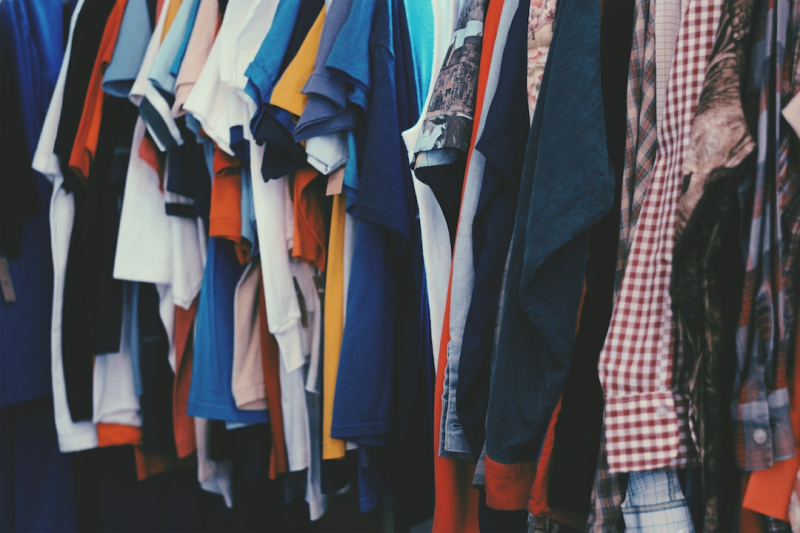Clothing, worn on the body, serves the primary purpose of protection but also represents personal, social, and cultural expression.
Materials range from natural products like cotton and wool to synthetic ones like polyester. Styles vary globally, reflecting cultural diversity, with western-style clothing being widespread due to globalization.
The concept of fashion, led by designers, signifies prevailing clothing styles and is a significant global industry. Recently, concerns have arisen over the environmental and social impacts of fast fashion, leading to a movement towards more sustainable and ethical practices. Clothing, while protective, plays a crucial role in [personal identity](/glossary/passport-photo-identity "Identity and Passport Photos", cultural expression, and societal trends.
Types of Clothing
Numerous categories of clothing exist:
- Shirts: T-shirts, Polo shirts, Dress shirts, Sweatshirts
- Tops: Blouses, Crop tops, Tank tops, Tunics
- Sweaters: Cardigans, Pullovers, Vests
- Jackets & Coats: Blazers, Bomber jackets, Trench coats, Pea coats, Parkas
- Pants: Jeans, Trousers, Chinos, Cargo pants, Sweatpants
- Shorts: Cargo shorts, Bermuda shorts, Gym shorts
- Skirts: A-line skirts, Pencil skirts, Maxi skirts, Mini skirts
- Dresses: Maxi dresses, Sundresses, Cocktail dresses, Evening gowns
- Undergarments: Underwear, Bras, Boxers, Briefs, Lingerie
- Sleepwear: Pajamas, Nightgowns, Robes
- Swimwear: Swimsuits, Bikinis, Swim trunks, Rash guards
- Suits: Business suits, Tuxedos, Tailcoats, Morning coats
- Traditional Clothing: Kimonos (Japan), Saris (India), Kilts (Scotland), Hanboks (Korea)
- Sportswear: Tracksuits, Jerseys, Leggings, Gym shorts
- Footwear: Sneakers, Boots, Heels, Sandals, Loafers
- Accessories: Hats, Scarves, Ties, Belts, Gloves
- Outerwear: Raincoats, Snow suits, Windbreakers
This list isn't exhaustive and there are many more specific types and subtypes within these general categories, varying by region, culture, occasion, and personal preference.
Rules for Clothing in Passport Photos
In passport photos, you should dress in a way that reflects your typical daily appearance. It's important to steer clearness of uniforms or anything that may resemble a uniform, such as military or law enforcement outfits.
However, if you wear religious clothing on a daily basis, it's perfectly acceptable to have it on in your passport photo. The key rule to remember is that your face must be clearly visible. This means you should avoid accessories like hats or sunglasses that can obscure your face.
Frequently Asked Questions
We will promptly send the photos, guaranteed within 24 hours and usually within 2 hours. The photos will be shipped from our headquarters in The Netherlands, via regular mail without tracking.
Why Was the Money Deducted From My Account for the Failed Order?When you cancel a payment or encounter an error, you will receive a notification email. If you make another attempt and successfully place the order, the payment will be deducted from that transaction.
Are Facial Piercings Allowed in Passport Photos?The issueing authorities of United States are lenient about piercings as long as they don't obscure your face. Our passport photo software refers to the official guidelines provided by the U.S. government to ensure compliance with its specific requirements.
- Glossary
- AI
- Aberration
- Acceptance Criteria
- Accuracy
- Age
- Anger
- Angle
- Aperture
- Apparel
- Appearance
- Artificial Light
- Attire
- Background
- Balance
- Bald
- Bangs
- Beanie
- Beard
- Bedridden
- Biometrics
- Blur
- Blushing
- Body Language
- Brightness
- Bun
- Burqa
- Camera Lens
- Camouflage
- Cap
- Cheeks
- Chest
- Chin
- Clarity
- Clearness
- Clothing
- Colors
- Compliance
- Composition
- Compression
- Contact Lenses
- Contrast
- Criteria
- Cropping
- Crown
- Crying
- DPI
- Daylight
- Detail
- Diffusion
- Dimensions
- Disability
- Disgust
- Distortion
- Distractions
- Double Chin
- Ear Attachments
- Earrings
- Ears
- Emotions
- Even Lighting
- Eye Bags
- Eyebrows
- Eyeglass Frame
- Eyelashes
- Eyelids
- Eyes
- Face
- Face Mask
- Facial Expression
- Facial Recognition
- Fear
- Feeding Tube
- Filters
- Fingerprint
- Flash
- Focus
- Forehead
- Frame
- Frowning
- Glare
- Glasses
- Glossiness
- Goatee
- Government
- Gradient
- Grain
- Hair
- Hair Gel
- Hairline
- Hairpin
- Hairspray
- Hairstyle
- Hat
- Head
- Head Tilting
- Headband
- Headgear
- Headphones
- Hearing Aid
- Hijab
- Hue
- ISO
- Identification
- Identity
- Identity Document
- Identity Theft
- Intensity
- Jaw
- Jewelry
- Joy
- Laughing
- Legitimation
- Lighting
- Lips
- Lipstick
- Makeup
- Microchip
- Mirroring
- Mouth
- Mouth Corners
- Municipality
- Mustache
- Myopia
- Natural Representation
- Neck
- Necklace
- Neutral Expression
- Nose
- Nose Job
- Nostrils
- Overexposure
- Overweight
- Pattern
- Personal Data
- Photo Paper
- Photo Printer
- Photo Quality
- Piercing
- Pixels
- Plain
- Ponytail
- Positioning
- Posture
- Presbyopia
- Privacy
- Pupils
- Recent
- Recognizable
- Red Eyes
- Reflections
- Resemblance
- Resize
- Resolution
- Retouching
- Sadness
- Saturation
- Scarf
- Scowling
- Security
- Selfie
- Selfie Stick
- Shadows
- Sharpness
- Shining
- Shoulders
- Shutter Speed
- Skin
- Skull
- Smiling
- Smudge
- Solid
- Spasm
- Speckling
- Strabismus
- Suitable
- Sunglasses
- Support
- Surface
- Surprise
- Sweating
- Tattoos
- Teeth
- Texture
- Throat
- Tie
- Tongue
- Torso
- Toupee
- Travel Document
- Tripod
- Turban
- Turtleneck
- Underexposure
- Uniform Background
- Uniforms
- Validity
- Visibility
- Wheelchair
- Wig
- Wrinkles
- Zoom
Don't Have Time Now?
Leave your email so that we can send you a discount coupon to continue later.
Oops! Usage Limit Reached
To maintain fair use of our service, we’ve set a limit of checks per user.
For photographers and other businesses with higher volume needs, please contact us about extended access options at hi@rostrio.com.
Thank you for your understanding!
